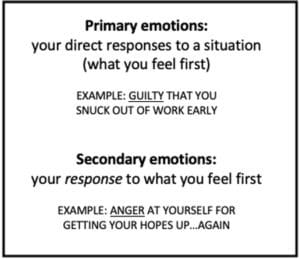By Brooke Schwartz, LMSW
Think about the last time you were angry — like, really angry. You might be thinking of the time you waited at a coffee shop for someone who never showed, when you arrived at the airport only to learn that your flight was cancelled, or when someone cut you off on the road and almost caused a car crash.
Experiencing anger is a natural part of being human. It’s a universal emotion, one that shows up frequently and at different levels of intensity. So what if you found out that there’s more to anger than meets the eye?

It’s ten minutes past the hour and you think they must be running behind. But as ten minutes turn into fifteen (and then twenty and thirty), you become frustrated. You ask yourself, “What kind of person doesn’t show to a meeting without sending an email first?” Your jaw clenches. You think, “This is a sign from the universe that I’m destined to be unhappy.” Your fists tighten. You are angry.
But that’s probably not all. What many don’t know about anger is that it’s often experienced in response to other emotions.

Primary emotions are what you first feel when you encounter a situation or event. The primary emotions that may have shown up in the above situation may include:
-
Disappointment that the meeting wouldn’t take place
-
Sadness that you have to continue in your current position
-
Fear that you won’t find another job
-
Guilty that you left work early
Secondary emotions are what you feel about that initial emotional response (or responses). They may involve judgments or interpretations that go beyond the actual facts of the situation, and they can be quick to show up, making it difficult to identify what’s actually underneath them. Examples of secondary emotions that could mask underlying emotions in this situation may include:
-
Anger (in response to feeling disappointment, sadness, and fear)
…at yourself for getting your hopes up about the job
…at the world for never cutting you a break
…at the other person for not showing up
-
Insecurity (in response to feeling disappointment) that the person you were supposed to meet perhaps thought you were underqualified or not worth their time
-
Paranoia (in response to feeling guilt) that someone from work may walk into the coffee shop and think you were blowing off work
-
You don’t even know what you’re really feeling. In these instances, your body and brain may default to anger. This is often the case for people who feel like they’re ‘always angry’.
-
You want to feel in control. There’s no denying that it’s uncomfortable, undesirable, painful, and even paralyzing at times to sit in certain emotions, such as sadness and fear. You may (oftentimes mistakenly) think you’ll be more productive or motivated when you experience anger — for example, by having an “I’ll show them what they’re missing” mentality in this kind of situation.
-
You’re insecure about feeling what you really feel. You may have learned that it’s not acceptable to experience or express certain emotions, such as sadness or fear, in situations like these. Hearing statements like, “Don’t be sad —there will be other opportunities!” or, “Just pull yourself up by your bootstraps” in this kind of situation may lead you to gravitate away from your primary emotions. Maybe you’ve even been punished in the past (e.g., called sensitive or weak) when you’ve been vulnerable and expressed your true emotions.
The problem with focusing only on secondary emotions like anger — and not identifying or paying attention to primary emotions, is that they mask your underlying — true emotions which tell you valuable information about what your actual needs are. If you can’t identify and describe your true emotions, you’ll have difficulty changing them and they might linger longer than they would if you addressed them head-on.
Stay tuned for our next blog where we’ll discuss how to figure out whether anger is a primary or secondary emotion, and what to do about it when it shows up!
Disclaimer
This site is for information only. It is not therapy. This blog is only for informational and educational purposes and should not be considered therapy or any form of treatment. We are not able to respond to specific questions or comments about personal situations, appropriate diagnosis or treatment, or otherwise, provide any clinical opinions. If you think you need immediate assistance, call your local emergency number.
For referral information about our services, please click here or see our contact page on our website.
